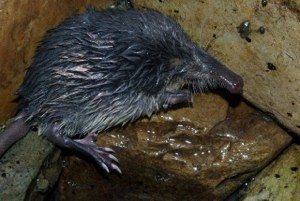Scientists and enthusiasts in Russia are tracking down the Russian desman to save it from extinction

By the end of the 19th century, only two species of desman remained in Europe: the Pyrenean desman (Galemys pyrenaicus) and the Russian desman (Desmana moschata). Russian NGOs now put an effort into bringing the country’s endemic species back. Severely damaged first from hunting and then from other anthropogenic impacts the species numbers are on a gradual decline. An attempt to restore the population is made by capturing and breeding the animal in captivity.
The Russian desman – an aquatic mole
The Russian desman occurs only in floodplain lakes and slowly flowing rivers in the Volga, Dnieper, Don, and Urals basins. They make their nests on the shoreline under vegetation and roots above the high water line. All entrances lead from the nest to below water.
Despite its outward similarity to muskrats, the Russian desman is actually part of the mole family Talpidae in the order Eulipotyphla. Like other moles, it is functionally blind and obtains much of its sensory input from the touch-sensitive organs at the end of its flexible long, grooved snout. The forefeet are partially and the hind feet are completely webbed. The tail is flattened horizontally and has scent glands at its base that exude a strong musky odour.
Near extinction
Desman’s musk used in the perfume industry was one of the reasons behind desman’s hunting. Another reason was its rich and thick fur used in clothing and highly sought after by the fur trade. Thus in 19 century due to uncontrolled hunting, the Russian desman first came to the brink of extinction.
A complete ban on Russian desman catchment and inclusion of species into the Red Data Book of the USSR stabilized the situation for a while, but the numbers continued dropping. Active deforestation and agricultural development led to the reduction of the Russian desman’s range in the late 19th and beginning of the 20th century. The construction of a network of hydroelectric power stations on the Volga and subsequent flooding of the floodplains took another heavy toll on the species. At the end of the 20th century, the collapse of the USSR, the default and the lack of money and resources led to excessive fishing by the population. The emergence of cheap Chinese fishing line networks at that time made poaching the most significant factor in desman collateral destruction.
Conservation attempts
Since the beginning of the 20th century, there were two main approaches to the problem of preserving the Russian desman: the creation of a network of nature reserves, as well as desman’s resettlement and acclimatization in new habitats.
To restore the number of the Russian desman three special reserves were created: Oka Nature Reserve, The Khopyor Nature Reserve and Klyazma Nature Reserve. The creation of protected areas helps to preserve biotopes inhabited by desman and fight against poaching. However, climatic changes leading to droughts and lack of floods are currently the most significant and negative factors affecting the state of desman habitats.
The species is listed in the IUCN Red List of Threatened Species and the Red Data Book of the Russian Federation, in which it has been transferred to the first category (endangered) since 2020. For such species, a special conservation and restoration strategy is developed. The most effective recovery method is to breed such animals in captivity and then release them into the wild.
Attempts to breed desman in captivity have been made repeatedly, for example, in the Moscow Zoo or in the Khopyor Nature Reserve. A technique for keeping desmans in captivity was developed but attempts to achieve desman’s reproduction in captivity failed.
Current research
In 2020, The Biodiversity Conservation Center (BCC), a non-profit, non-governmental organization based in Moscow, received a presidential grant to establish a Russian desman’s nursery near Moscow. It is a unique project with promising environmental and social perspectives. Having collected and applied all their limited knowledge about the desman (this is still one of the most unexplored species), scientists and conservationists are going to make another attempt to breed the animal in captivity. The nursery is created at the Kropotovo biostation of the Koltsov Institute of Developmental Biology RAS. Everything is ready to receive animals, the only thing left to do is to catch a desman.
Desmana club, the so-called group of Russian Desmana’s friends that consist of students biologists and other enthusiasts under the leadership of the Doctor of Biological Sciences Marina Vladimirovna Rutovskaya, usually performs their desman counts in autumn, when the water level in reservoirs is rather low. Desmans are counted in special wetsuits, walking in the water along the coast. The researchers search for desman’s burrows by probing the bottom with their feet and examining the remains of food. Based on the results of the survey, it is determined whether the animal lives in the lake. This is complex and hard work that requires good theoretical and physical preparation. There are also other techniques for monitoring. Moving underwater, the animal leaves a trail of exhaled air bubbles. During the installation of the first ice, these bubbles freeze into it in the form of a track and become noticeable. This is a sign that a desman lives in the pond.
Species on the run
This year the group received special permission for capturing several individuals of the Russian desman in the buffer zone of the Prisurski Nature Reserve (Chuvashia), alongside with its counts there, in Volga-Kama Nature Reserve (Tatarstan) and in the Smolny National Park (Mordovia). The group searched for the burrows, set up live traps, but it was unable to catch the animals. The desman continues to stay elusive. The attempts will continue next year.

